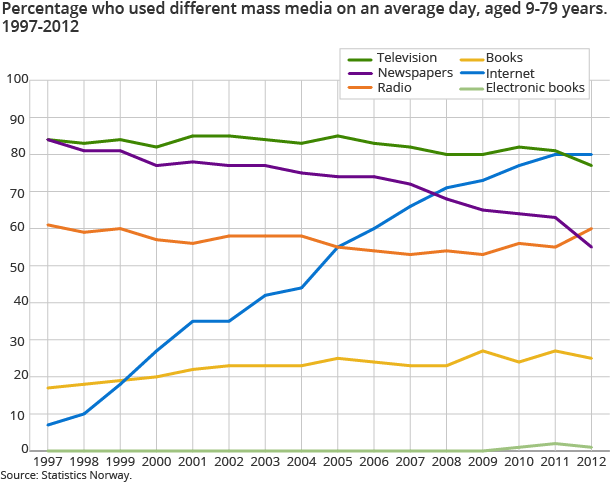Content
Published:
This is an archived release.
Less time for TV, more for Internet
The percentage of the Norwegian population reading printed papers and spending time watching TV per day is declining, while the time spent on the Internet has increased from 2011 to 2012. Listening to radio is also increasing. Only one per cent reads electronic books in a typical day.
| 1991 | 2000 | 2011 | 2012 | |
|---|---|---|---|---|
| Newspapers | 84 | 77 | 63 | 55 |
| Television | 81 | 82 | 81 | 77 |
| Radio | 71 | 57 | 55 | 60 |
| Records/Cassettes/CD/MP3 | 43 | 50 | 38 | 40 |
| Weeklies | 21 | 17 | 12 | 10 |
| Books | 24 | 20 | 27 | 25 |
| Magazines | 18 | 14 | 12 | 9 |
| Cartoons | 11 | 9 | 5 | 4 |
| PC | .. | 25 | 70 | 70 |
| Video | 10 | 10 | 14 | 11 |
| Internet | .. | 27 | 80 | 80 |
There has been a decline in reading printed newspapers on an average day among persons 9-79 years in the last year. In 2012, 55 per cent of the population read one or more printed newspapers on an average day, compared to 63 per cent in 2011. In 1997, the percentage was 84.
More time for Internet
The proportion of people using the Internet has grown considerably in recent years, but there has been no increase from 2011 to 2012. In both years the percentage was 80. Time spent on the Internet has on the other hand increased, from 86 minutes in 2011 to 95 minutes in 2012. On average, time spent on the Internet is at a record high.
Less time in front of the TV
The proportion watching TV on an average day has remained rather stable in recent years, with a slight decline from 81 per cent in 2011 to 77 per cent in 2012. The decline primarily applies to children and the young. Time spent watching TV has also declined considerably.
13 per cent listen to DAB radio
The percentage listening to radio during a day has increased from 55 per cent in 2011 to 60 per cent in 2012. The increase primarily applies to people in the age group 45-66 years. Thirteen per cent listened to a DAB radio during the day.
Fall in the use of CDs
Sixty-seven per cent of those who used sound systems on an average day in 2012 listened to audio files from the Internet. In 2011, the percentage was 64. The proportion using CD players is declining; from 47 per cent in 2011 to 36 per cent in 2012.
The percentage of book readers on an average day was 17 in 1997. This has subsequently increased. In 2011, it was 27 per cent, and in 2012 it decreased to 25 per cent. The share of persons who read weekly publications and cartoon publications on an average day has changed little from 2011 to 2012.
One per cent read electronic books
Thirteen per cent of the population played TV games or computer games during an average day in 2012. In addition, 3 per cent used palmtop games consoles. Eighty per cent had a private mobile phone conversation and 35 per cent used the Internet via a mobile phone. One per cent read electronic books during the day.
28 per cent have a DAB radio
Forty-three per cent had access to a hard disc recorder in their household in 2012, compared to 41 per cent in 2011. Ninety-five per cent had access to the Internet in the household, compared to 92 per cent in 2011. Twenty-eight per cent had a DAB radio in 2012, compared to 22 per cent in 2011. Sixty-two per cent of the population had one or more newspaper subscriptions in their household in 2012. In 2011, the percentage was 68.
For further reading, refer to the Norwegian media barometer for 2012.
Contact
-
Emma Schiro
E-mail: emma.schiro@ssb.no
tel.: (+47) 91 39 78 91
-
Emmie Stolpe Foss
E-mail: emmie.foss@ssb.no
tel.: (+47) 40 81 14 30
-
Elisabeth Haraldsrud
E-mail: elisabeth.haraldsrud@ssb.no
tel.: (+47) 40 81 15 00

